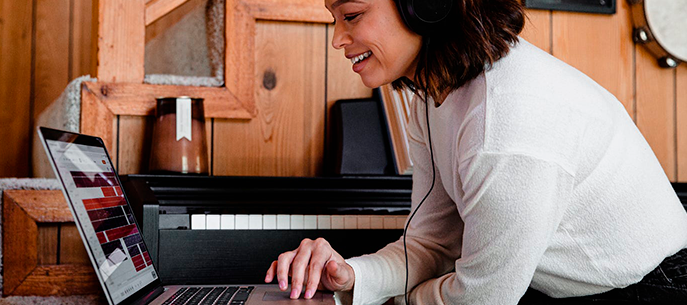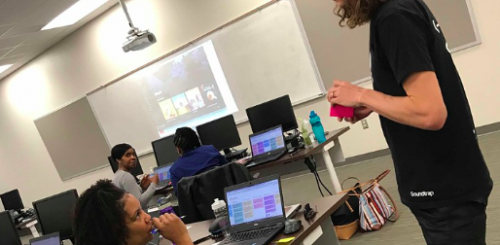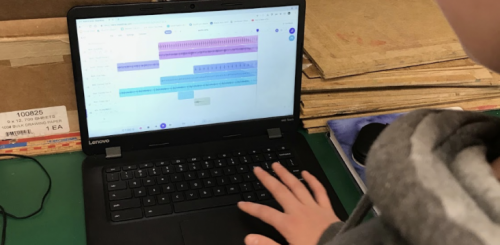
Finding the Best DAW for Students
September 5, 2023The age of technology has revolutionized various sectors, and the educational realm is no exception. One area where this change is palpably felt is in how students interact with music and sound. Enter the digital audio workstation, or DAW, a tool that’s swiftly finding its place in modern classrooms.
There are quite a few digital audio workstations on the market today, but some are better than others. If you’re ready to find the best DAW for your students, we’ll help you learn which features to look for so you can create engaging learning experiences that your pupils will remember for a lifetime.
What Is a DAW and Why Is It Essential for Students?
A digital audio workstation (DAW) is essentially a software platform that allows users to record, edit, and produce audio files. Picture it as a high-tech digital studio right inside your computer or tablet. While DAWs are a staple in professional music studios, they’re also gaining traction in the realm of education.
Even if you’re not a music teacher, your students can experience the benefits of using a DAW, which include:
- Creativity Unleashed: In an age where creativity is as valued as academic rigor, DAWs empower students to compose music, dabble in sound design, or even produce their very own podcasts.
- Skill Development: Working with a DAW helps students develop technical skills, from understanding sound waves to mastering audio editing techniques.
- Multidisciplinary Learning: DAWs can be integrated into various subjects. Imagine a history project with self-composed background scores or a literature class where students create soundscapes for the stories they read.
Key Features to Look for in a DAW for Students
The landscape of digital audio workstations is vast, brimming with options tailored for professionals, hobbyists, and everyone in between. However, when it comes to students, not every DAW is ideal. The needs of a student learning the ropes of digital music production are unique and require specific features for an optimal learning experience.
A User-Friendly Interface
A student’s first interaction with a DAW should be inviting, not intimidating. While professional-grade DAWs offer a plethora of tools and features, they might be overwhelming for newcomers. A student-focused DAW like Soundtrap for Education offers a streamlined, intuitive interface that simplifies complex processes.
For instance, clear labeling, easily identifiable icons, drag-and-drop functionalities, and a clean workspace can make navigation easier. A DAW that minimizes the technical barriers allows students to focus on the creative aspect of music production, ensuring they remain engaged and motivated.
Educational Discounts for Students
Cost can be a significant barrier for students and educational institutions. Many premium DAWs come with hefty price tags, making them less accessible for students who might be on a budget. However, some DAW providers recognize the importance of nurturing budding talent and offer educational discounts. Some even provide free or “lite” versions specifically tailored for students.
While these versions might have limitations compared to their full-fledged counterparts, they often include all the essential tools required for a student to understand the basics of music production. Such initiatives ensure that every student, irrespective of financial constraints, can dive into the world of digital audio production.
Built-In Tutorials and Learning Resources
One of the most significant challenges students face when starting with a new DAW is understanding its functionalities. Built-in tutorials and learning resources can bridge this gap. A good DAW for students will typically come equipped with a library of tutorials, covering everything from the basics to more advanced features. These can be in the form of video tutorials, interactive guides, or textual resources.
Furthermore, some DAWs incorporate active communities where learners can ask questions, share their work, and receive feedback. This not only aids the learning process but also fosters a sense of community and collaboration among users.
Compatibility with Popular School Devices
The modern classroom is no longer restricted to notebooks and pencils. Devices like Chromebooks and iPads have become staples in many schools, aiding digital learning. A DAW tailored for students should be compatible with these devices.
Such compatibility ensures that students can seamlessly integrate their music projects into their regular schoolwork. For instance, if a student starts a project on a classroom iPad, they should be able to easily continue it on a Chromebook or even a home computer. This flexibility not only aids in uninterrupted learning but also ensures that students can work on their projects anytime, anywhere.
How You Can Bring the Best DAW to Your Classroom
Although most educators associate DAWs with music creation, there are plenty of ways that you can use these modern EdTech tools to take your curriculum to the next level. Try incorporating Soundtrap for Education into your curriculum with these fun ideas!
Podcast Creation for Class Projects
In the era of digital media, podcasts have surged in popularity as an engaging and informative medium. Integrating podcast projects into the classroom can foster several key skills:
- Research and Scripting: Before hitting the record button, students will need to research their chosen topic, ensuring accuracy and comprehensiveness. This phase also requires them to craft a script, promoting their writing skills.
- Technical Skills: Using a DAW, students will record their podcast episodes, learning the intricacies of sound recording and audio editing in the process.
- Communication Skills: A good podcast is built on clear and effective communication. Students will hone their speaking skills, ensuring they articulate their points compellingly and understandably.
- Collaboration: Podcasts often involve multiple roles, including hosts, producers, and editors. This can encourage teamwork as students collaborate to produce their episodes.
Music Composition to Hone Creative Thinking Skills
Every classroom harbors potential musicians waiting for an outlet to unleash their creativity. DAWs can be that platform, providing the following opportunities.
- Experimentation: With a myriad of virtual instruments and sound samples, students can experiment with different genres, rhythms, and melodies, finding their unique sound.
- Songwriting and Composition: Beyond just creating beats, students can pen down lyrics, set them to melodies, and craft full-fledged songs. This promotes both their musical and literary skills.
- Sharing and Feedback: Once their compositions are ready, students can share them with peers, teachers, or even the world. This not only builds their confidence but also provides them with constructive feedback, essential for growth in any art form.
Simple Tips for Educators Introducing DAWs to Their Students
The best DAW will offer a plethora of opportunities for educators to make learning more interactive and enriching. However, integrating these tools effectively into the classroom requires a strategic approach. Here are some tips for educators who are keen to introduce DAWs to their students.
Get Started with the Basics
Before diving into the deep end of music composition, it’s crucial to ensure that students have a firm grasp of the foundational skills.
- Understanding the DAW Interface: Familiarize students with the basic layout, from the timeline and track views to toolbars and effect racks. An initial guided tour can help eliminate any intimidation they might feel.
- Basic Editing Techniques: Introduce students to fundamental editing tasks like cutting, fading, looping, and layering sounds. By mastering these, they’ll find more complex tasks approachable.
- Experimentation: Encourage students to play around with different sound samples and effects. A hands-on approach can be the quickest way to learn.
By cementing these foundational skills first, educators ensure that students are well-equipped to tackle music composition confidently.
Encourage Group Work
The collaborative nature of DAWs makes them perfect for group projects.
- Diverse Roles: In any DAW project, there are multiple roles like sound engineer, composer, and editor. Assigning different roles to students can not only help distribute the workload but also ensure that they learn various aspects of DAW operations.
- Peer Learning: Students often learn best from their peers. Group work allows them to share techniques, troubleshoot problems collectively, and inspire one another with creative ideas.
- Feedback and Iteration: Once a group project is complete, encourage other groups to provide feedback. This iterative process helps students refine their work, promoting a culture of continuous improvement.
Using DAWs to Meet Learning Goals
DAWs aren’t just for music or media classes. Their applicability spans various subjects, such as:
- History and Literature: Students can create audio documentaries or dramatic readings, integrating sound effects and music to make historical events or literary pieces come alive.
- Foreign Languages: For foreign language classes, students can record dialogues or narrations, honing their pronunciation and intonation.
- Science: In subjects like physics, students can demonstrate concepts like sound waves, frequencies, or resonance using a DAW.
By aligning DAW projects with curriculum objectives, educators can ensure that students not only learn how to use the software but also deepen their understanding of core academic subjects.
Use the Best DAW for Students: Soundtrap for Education
Soundtrap for Education is the ultimate audio production platform for students and teachers to create and edit audio recordings. Pupils and educators can easily tap into their artistic side with this intuitive audio platform that facilitates a creative learning environment for every subject, regardless of the student’s age or experience level.
With Soundtrap for Education, students and teachers can collaborate with advanced cloud technology at any time or place. In addition, the platform comes equipped with a robust resource portal, with tutorials, an external curriculum, and lesson plans to complete the educational experience. And to ensure privacy, teachers can keep student collaboration safe and secure with invite-only groups in Soundtrap’s versatile digital environment.
If you’re ready to enhance your educational experience with an intuitive cloud-based audio production platform, start with Soundtrap for Education! And be sure to share this article with other teachers in your network to help spread the joy of learning through sound.
 EDU Portal
EDU Portal


